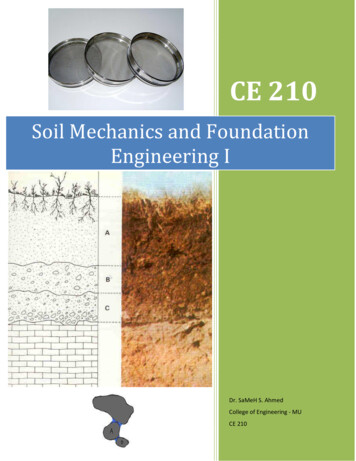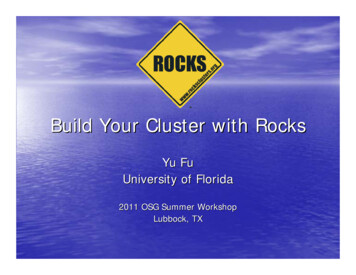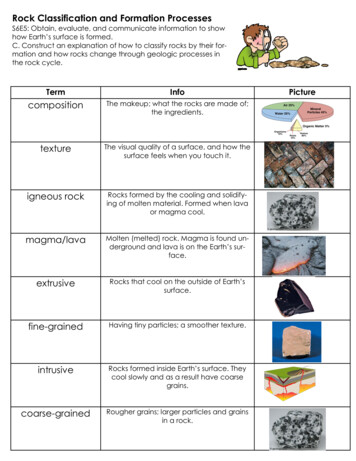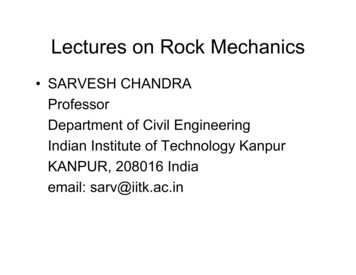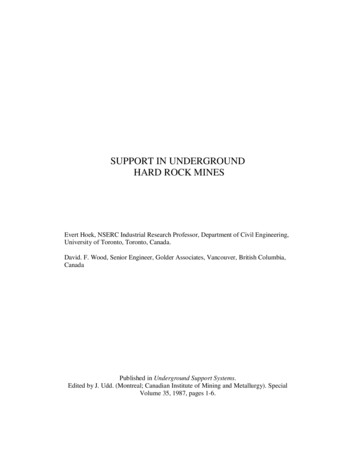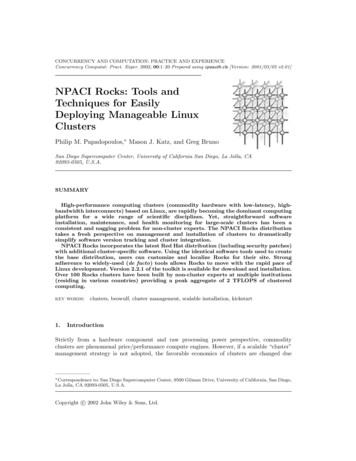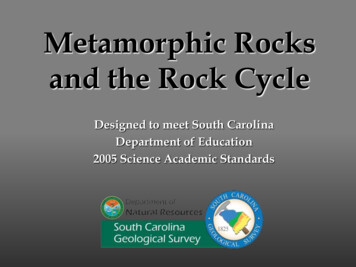
Transcription
Metamorphic Rocksand the Rock CycleDesigned to meet South CarolinaDepartment of Education2005 Science Academic Standards
Table of Contents What are Rocks? (slide 3) (Standard: 3-3.1 (covers slides 3-26))Major Rock Types (slide 4)The Rock Cycle (slide 5) Metamorphic Rocks (slide 6) Metamorphism (slide 7) Metamorphic Conditions (slide 8) Causes of Metamorphism (slide 9-11) Heat (slide 9) Pressure (slide 10) Chemically Active Fluids (slide 11) The Role of Parent Rocks in Metamorphism (slide 12) Classifying Metamorphic Rocks by Different Textures (slide 13) Foliated Rock Textures: (slide 14-17) Slaty Cleavage (15), Schistocity (16), and Gneissic (17) Foliated Metamorphic Rocks: (slide 18-22) Slate (19), Phyllite (20), Schist (21), and Gneiss (22) Nonfoliated Rock Textures (slide 23) Marble (slide 24) Quartzite (slide 25) Metamorphic Rocks in the Landscape (slide 26) Metamorphic Rocks in South Carolina (slide 27)South Carolina Science Academic Standards (slide 28)Resources and References (slide 29)2
What are Rocks? Most rocks are an aggregate of one or more minerals,and a few rocks are composed of non-mineral matter.There are three major rock types: 1. Igneous 2. Metamorphic 3. Sedimentary3Table of Contents
Major Rock Types Igneous rocks are formed by the cooling of moltenmagma or lava near, at, or below the Earth‟s surface.Sedimentary rocks are formed by the lithification ofinorganic and organic sediments deposited at or nearthe Earth‟s surface.Metamorphic rocks are formed when preexistingrocks are transformed into new rocks by heat andpressure below the Earth‟s surface.4Table of Contents
The Rock Cycle5Table of Contents
Metamorphic Rocks Metamorphic rocks are formed when existing parent rocks aretransformed (metamorphosed) by heat and pressure deep belowthe surface of the earth or along the boundary of tectonic plates.The three primary causes of metamorphism include one or moreof the following conditions: heat, pressure, and/or chemicallyactive fluids.During metamorphism, rocks may fold, fracture, or even partiallymelt to a viscous state and flow before reforming into a new rock.Metamorphic rocks change in appearance, mineralogy, andsometimes even chemical composition from their parent rocksource.6Table of Contents
Metamorphism Metamorphism can occur along a range of heat and pressureintensities from low- to high-grade metamorphism.Low-grade metamorphism involves lower temperature andcompressional forces that result in less overall change to the parentrock. In many cases, after low-grade metamorphic changes theparent rock may still be easily distinguishable.High-grade metamorphism results in a total transformation of theparent rock into a new rock whereby its original parent-rock sourceis difficult to identify.7Table of Contents
Metamorphic Conditions 1. Contact or Thermal Metamorphism: occurs when parent rock isintruded by magma (usually an igneous intrusion). Metamorphicchanges under these conditions are primarily the result of temperaturechanges associated with the intruding magma. Additionally, when hotion-rich water circulates through fractures in a rock, it can also causechemical changes to the parent rock. These heat-driven, chemicalreactions occur with igneous activity and the presence of water.2. Dynamic Metamorphism: occurs when rocks are subjected toextreme pressure very rapidly. Two situations are noted, (a.) fault zonesand (b.) impact craters. (a.) In the upper crust, faults are planar zones ofcrushed rock. The heat generated by friction during faulting can meltand metamorphose portions of the rock. (b.) Impact craters formed byextra-terrestrial objects (meteorites) colliding with the earth arecommonly identified by exotic high-pressure minerals formed duringthe meteorite crash. Stishovite and coesite, both are high-pressure formsof quartz resulting from meteor impacts.3. Regional Metamorphism: occurs when rocks are subjected to bothheat and pressure on a regional scale. It is caused by burial deep in thecrust and is associated with large scale deformation and mountainbuilding. It is the most widespread form of metamorphism.8Table of Contents
Causes of Metamorphism: Heat Heat provides energy for chemical reactions to proceed resulting innew minerals to form from original minerals in the source rock.Heat provides the energy that enables individual ions in the rock tomobilize and migrate between other ions recrystallizing andforming into new minerals.Heat involved in metamorphism comes from two main sources: 1. Heat transferred during contact metamorphism from magma origneous intrusions.2. Progressive temperature increase associated with geothermal gradientas rocks are transported to greater depths below the Earth‟s surface.9Table of Contents
Causes of Metamorphism: Pressure Pressure equals force per unit area: (Pressure F/A).Pressure increases with depth as the weight and thickness of theoverlying rocks increases.Pressure during metamorphism is manifested by two differentforces: body force (confining pressure) and surface force(differential stress). Body force —forces are applied equally in all directions (gravity andweight), as a result individual grains are compressed closer and closertogether. Extreme confining pressures that occur at great depths mayeven cause ions in the minerals to recrystallize and form new minerals.Surface force —operates across a surface and occurs when rocks arecompressed or extended along a single plane (push-pull forces). As aresult, the rocks are shortened or extended in the direction the pressureis applied. Near the Earth‟s surface, the cooler temperatures make rocksbrittle and more susceptible to fracturing than folding. Deep below theEarth‟s surface, higher temperature conditions, make the rocks ductileand they flatten and elongate as oppose to breaking along a fracture, the10resulting rocks then exhibit intricate folding patterns.Table of Contents
Causes of Metamorphism:Chemically Active Fluids Chemically active fluids that are present between mineral grainsduring metamorphism act to facilitate ion movement and the recrystallization of existing and new minerals.Higher temperatures increase the reactive capability of ion-richfluids. When these fluids come in contact with mineral grains, thegrains readily dissolve because of differential chemical potentials,and ions migrate to areas of lower potential eventuallyrecrystallizing.Chemically active fluids have the ability to move between differentrock layers and transport ions from one rock to another before theyrecrystallize.11Table of Contents
The Role of Parent Rocks inMetamorphism Parent rocks provide the minerals and ion sources that aretransformed into new minerals and rocks.In most cases the new metamorphic rock has the same chemicalcomposition as the parent rock that they formed from.Examples of parent rocks and their metamorphic MarbleMetamorphic12Table of Contents
Classifying Metamorphic Rocks byDifferent Types of Textures Texture is used to describe the size, shape, and arrangement ofgrains within a rock.The different textures of mineral grains within metamorphic rocksare used to infer information about the conditions which formedthem.Many of the mineral grains in metamorphic rocks displaypreferential orientations where the alignment of the minerals isparallel or subparallel to one another.Rocks that exhibit parallel or sub-parallel orientation arecategorized as foliated, while those that do not exhibit orientationsare categorized as nonfoliated.13Table of Contents
Foliated Rock Textures Foliation is broadly defined as any planar arrangement of mineralgrains or structural features in a rock. Foliation can occur in bothigneous and metamorphic rocks (this section will only focus onfoliation in metamorphic rocks).Foliation in metamorphic rocks occurs when the minerals in therock align and recrystallize along planes of parallel orientation as aresult of heat and compressional forces.Minerals recrystallize into platy, elongated, or flattened grains,according to their original crystal habits. They segregate into thinlayers that appear as thinly banded slivers of minerals interlayeredtogether.Different textures used to describe foliation include: slaty cleavage,schistosity, and gneissic texture.14Table of Contents
Foliated Textures: Slaty Cleavage Slaty cleavage is used to describe rocks that split into thin, planar slabswhen hit with a hammer.Rocks with slaty cleavage often contain alternating bands of differentminerals where one type of mineral (usually mica formed fromrecrystallized clay) forms highly aligned platy grains of foliated minerals.The rock will split into thin sections along these bands.Slaty cleavage commonly occurs under low-grade metamorphic conditions.The weathered exterior of this rock and brokenfragments show an example of slaty cleavagefrom the Carolina Slate belt in South Carolina‟sPiedmont.Photo: SCGS15Table of Contents
Foliated Textures: Schistosity Schistosity describes rocks with foliated mineral grains that are largeenough to see without magnification.Schistocity occurs under medium-grade metamorphic conditions, and thecrystals have a greater opportunity to grow during recrystallization.Unlike slaty cleavage, which tends to preferentially affect some mineralsmore than others, schistosity tends to affect all the different mineralcomponents.Rocks with schistosity are generally referred to as schist.The foliated mineral grains of this schistprovide a good example of schistosity. Noticehow the rock weathers in flaky sections. Rockswith schistosity can easily crumble or brokeninto smaller pieces with bare hands.16Photo: SCGSTable of Contents
Foliated Textures: Gneissic Gneissic textures occur when the silicate minerals in the rock separate andrecrystallize into alternating bands of light (quartz and feldspar) and dark(biotite, amphibole, or hornblende) grains of silicate minerals.The mineral alignment in gneissic rocks is less platy and more granular orelongated than slaty cleavage or schistosity.The alternating quartz and biotite bands inthis rock characterize gneissic texture. Thisphoto also illustrates an example of foldingthat results from the intense heat andpressure of metamorphic conditions.Photo: SCGS17Table of Contents
Foliated Metamorphic Rocks SlatePhylliteSchistGneissPhoto: SCGSSouth Carolina‟s Piedmont is composedprimarily of foliated metamorphic rocks. Inmany locations different metamorphic rocktypes occur in close proximity. Many of themetamorphic rocks in this region are folded andfaulted, making for very exciting geology.Photo: SCGS18Table of Contents
Foliated Rocks: Slate Slate is a fine-grained rock composed of mica flakes and quartzgrains that enable the rock to break into thin slabs of rock, alongplanes of slaty cleavage.Slate forms in low-grade metamorphic environments from a parentrock of either shale, mudstone, or siltstone.Slate is commonly thought of as black, but it can also be red when itcontains iron oxide minerals, or green when it contains chlorite.Weathered slate may even appear light brown in the example below.This example of slate is part of the CarolinaSlate belt which traverses through thePiedmont of South Carolina. This imagealso provides a good example of the slatycleavage that has also been folded.19Photo: SCGSTable of Contents
Foliated Rocks: Schist Schist exhibits schistosity, which is formed by the alignment ofplaty medium- to coarse-grained minerals formed under moderateto high-grade metamorphic conditions.Schists are primarily composed of silicate minerals such as mica(muscovite and biotite), quartz, and feldspar .Shale, siltstone, and some sandstones can provide the parent rockfor schist.Schist may contain accessory minerals such as garnet, tourmaline,and pyrite.This schist is from the Piedmont region inSouth Carolina. Notice how the differentlayers are weathering at slightly differentrates, the layers of darker, mica rich schist areweathering more quickly than the tan,feldspar and quartz-rich layers.20Photo: SCGSTable of Contents
Foliated Rocks: Phyllite Phyllite is a low- to moderate-grade metamorphic rock that containsaligned platy mica minerals and has slaty cleavage.The individual crystals are fine grained and generally consist ofmuscovite, white mica, and chlorite (green rocks).Phyllite has a satiny appearance and waxy texture.Phyllite is a metamorphic form of shale, mudstone, and siltstone.These samples of phyllite all came fromthe same quarry in South Carolina. Theslaty cleavage of the phyllite is whatmakes it a foliated rock. As phylliteweathers it parts along the cleavageplanes.21Table of Contents
Foliated Rocks: Gneiss Gneiss is a medium- to coarse-grained rock formed under highgrade-metamorphic conditions.Gneiss is primarily composed of quartz, potassium feldspar, andplagioclase feldspar with lesser amounts of biotite, muscovite, andamphibole.Granites and sometimes rhyolite provide the parent rock for gneiss.Gneisses are generally light colored becausethey contain a large amount of quartz andfeldspar. The alternating light and dark bandsin this gneiss illustrate the segregation ofdifferent minerals during crystallization. Thisexample also shows folds in the rock. Thisgneiss most likely formed from ametamorphosed igneous intrusion. SouthCarolina‟s Piedmont and Blue Ridge containgneissic bedrock.Photo: SCGS22Table of Contents
Nonfoliated Rock Textures Nonfoliated rock textures form under two basic conditions,metamorphism of monomineralic rocks and metamorphism in theabsence of directed stress.Nonfoliated textures form during recrystallization ofmonomineralic rocks where the distribution of mineral growth isapproximately equal, i.e. minerals grow at same rate and to samesize.In the absence of directed stress, minerals with high aspect ratioare randomly oriented and show no preferential alignment.Marble is an example of a metamorphic rock with a nonfoliatedtexture.23Table of Contents
Nonfoliated Rocks: Marble Marble is a nonfoliated, coarse-grained metamorphic rock formedfrom the parent rock limestone or dolostone.Because it is formed from limestone or dolostone it is predominantlycomposed of the mineral calcite, which metamorphoses into variouscarbonate and other minerals. As calcite recrystallizes, all the grainsare active at the same time and they grow to the same size and shape,which leads to its nonfoliated texture.Different color schemes in marble are the result of impurities or thepresence of weathered materials deposited in or near the limestone.Marble is used as a building material and ispopular for sculpture. The word „marble‟derives from a Greek word that translates as“shining stone” because it can be polished.Limestone that metamorphoses into marblemay contain a lot of fossils; however, the heatand pressure of metamorphism destroyspreexisting features primarily throughrecrystallization.24Copyright Dr. Richard BuschTable of Contents
Quartzite Quartzite is a metamorphic rock formed under moderate to highgrade metamorphism that exhibits both foliated and nonfoliatedstructure.The parent rock to quartzite is sandstone.Quartzite forms from the recrystallization of quartz grains in thesandstone and often the resulting metamorphic rock will preservevestiges of the original bedding patterns .Quartz is predominantly white in color, but can also containpinkish or grayish shades depending on the presence of ironoxides.This example of quartzite show a couple ofinteresting features. First, notice how thedifferent bedding planes have beenpreserved during the metamorphism.Secondly, there is a fault running though thequartzite that occurred after the formation ofthe rock. This particular example is of afoliated quartzite (due primarily to thepreservation of the bedding planes) howeversome quartzite rocks are classified asnonfoliated.25Table of Contents
Metamorphic Rocks in the LandscapeGrandfather Mountain, in North Carolina, is part ofthe Blue Ridge Province of the AppalachianMountains in the Eastern United States. The rocks inthis region began undergoing metamorphism nearly abillion years ago. Million of years later rocks fromAfrica collided with North America, before riftingapart to eventually form the Atlantic Ocean. Today,weathering and erosion of the surrounding landscapeexposes the metamorphosed rocks that make upGrandfather Mountain.Copyright Bruce Molnia @ Terra Photographicshttp://www.grandfather.com/The Snake Range Mountain in Great Basin NationalPark, Nevada, are metamorphosed sandstone rocks.These vertically oriented bedding planes were oncehorizontal layers of sediment deposits at the bottomof a sea. Nearly 200 million years ago thrusting,tilting, faulting, and uplifting metamorphosed thesandstone into quartzite. Another majormetamorphic event began about 30 million yearsago when the earth‟s crust began stretching in aneast to west direction. As a result the rocks faultedinto large blocks that tilted, producing the rockorientation we see today.26Table of Contents
Metamorphic Rocks in South Carolina27Table of Contents
South Carolina Science AcademicStandards: Grade 31) Earth‟s Materials and Changes:Standard 3-3:The student will demonstrate an understanding of Earth‟s composition and the changes that occur to the features ofEarth‟s surface. (Earth Science).Indicators:3-3.1: Classify rocks (including sedimentary, igneous, and metamorphic). (slides: 3-26 )28Table of Contents
Resources and ReferencesChristopherson, R. W. ,2002, Geosystems (4th ed.): Upper Saddle River, New Jersey, Prentice Hall.Christopherson, R. W., 2004, Elemental Geosystems (4th ed.): Upper Saddle River, New Jersey, Prentice Hall.Robertson, S., 1999, BGS Rock Classification Scheme, Volume 2, classification of metamorphic rocks: BritishGeological Survey Research Report (2nd Edition) , RR 99-03.Keller, E. A., 2000, Environmental Geology (8th ed.): Upper Saddle River, New Jersey, Prentice Hall.Lutgens, F. K., and Tarbuck. E. J., 2003, Essentials of Geology (8th ed.): Upper Saddle River, New Jersey, Prentice Hall.29Table of Contents
extreme pressure very rapidly. Two situations are noted, (a.) fault zones and (b.) impact craters. (a.) In the upper crust, faults are planar zones of crushed rock. The heat generated by friction during faulting can melt and metamor
